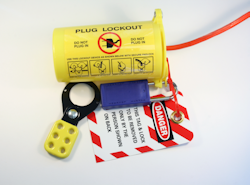Use Properly Guarded Machinery
Use Guards on Tools and other Equipment with Moving Parts
The employer must ensure hand-held power tools are fitted with guards and safety switches.
Woman Scalped
The type of guard will be determined by the power source of the tool (electric, pneumatic, liquid fuel, hydraulic, or powder-actuated).
Examples of guards:
- Exposed moving parts of power tools, such as belts, gears, shafts, pulleys, etc. must be guarded.
- Points-of-operation, where the work is actually performed on the materials, must also be guarded.
- Power saws are a primary type of equipment which requires a point-of-operation guard.
- In-running nip points, such as where the sanding belt runs onto a pulley in a belt sanding machine, must also be guarded.
Protective Clothing, Jewelry, and Long Hair
Be sure to remove personal protective equipment, loose clothing, and jewelry to prevent being caught by moving parts. Cover loose hair which can become entangled in moving machines and create a hazard. A protective glove can become caught between rotating parts causing multiple serious injuries or death. Long hair can get caught in rotating parts, pulling the worker into the machinery. Jewelry and loose clothing can catch on machine parts causing amputation or serious injury by pulling the hand/body into the machinery.
Use Other Methods to Secure Machinery
Use other methods to ensure that machinery is sufficiently supported, secured or otherwise made safe.
Make sure your equipment is de-energized and cannot be started accidentally by using lockout/tagout procedures.
- Disconnect tools when not in use, before servicing, and when changing accessories such as blades, bits, and cutters.
- Turn off vehicles before you do maintenance or repair work.
- If possible, lockout the power source to the equipment. The type of power source may be electric, pneumatic, liquid fuel, hydraulic, or powder-actuated.
- Lower or block the blades of bulldozers, scrapers, and similar equipment before you make repairs or when the equipment is not in use.
- Use lockout/tagout procedures for machinery and equipment used in concrete and masonry operations.
Knowledge Check Choose the best answer for the question.
2-2. To protect against caught-in or caught-between hazards, workers should _____.
You forgot to answer the question!

